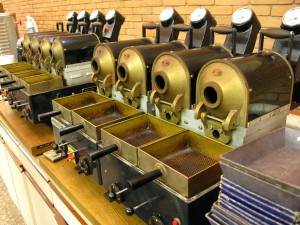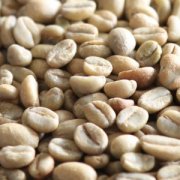Baking experience of Panamanian Coffee Raw Bean
The Panamanian beans at Brista Coffee West Point training School are very different from Essel beans. The particles are large and thick. It is not easy to be heated evenly, and experienced bakers will find that these beans are so nutritious that they are like superhuman beans raised by milk. If it heats up too fast, it will burn the beans. Resulting in half-cooked. If it's slow, it will make it smell like dry bread. Although Bristol Coffee West Point training school has a good taste of beans, many baking mistakes will retain a lot of good features. But are you willing to do it?
Panamanian coffee beans in roasting to reach 1 burst dense out of beans, can be shallow, but not over 1 burst.
Here's a baking curve to avoid some expensive mistakes:
Let's start with 1 explosion and 2 explosion.
After 1 explosion, it means that no more "bang" sound can be heard after the explosion.
Many people have also asked about the difference between the first explosion and the second explosion. We found that one thing to pay attention to is to achieve "dense": if the beans are baked unevenly, it is easy to blend into 2 bursts if the beans are not dense.
1 explosion is like a bullet to start, "explosion" after a few seconds, "explosion" after a few seconds, and then you will hear "explosion, explosion" this is not dense explosion. The sound of 1 burst is from scattered to dense, and then to scattered, and before it stops, it will be denser again, and the second time it will be hit by 2 explosions.
Brista Coffee West Point training School beans will lose a lot of its colorful flavor when they explode in 2. If you mix 1 and 2 explosions, part of your beans will be carbonized and some of them will still be developing. Such beans are easy to taste bitter when they are flushed by hand.
Is it possible that the explosion is not dense? That's for sure. If the beans are right and the baking is right, it must be possible. You happen to mix well-flavored shallow beans with deeper mellow beans, and the proportion is perfect. There will be good beans. But in practice, how many people can control the distribution of the beans? Can the uniformity be the same every time? In addition, even if the skilled baker answers yes. The next time this bean has a little more moisture due to environment, storage, processing or other reasons, its density has changed a little bit due to nutrition, and its distribution has changed a little bit-can you still guarantee it? Therefore, in order to stabilize the production, we advocate that it should be intensive first.

Important Notice :
前街咖啡 FrontStreet Coffee has moved to new addredd:
FrontStreet Coffee Address: 315,Donghua East Road,GuangZhou
Tel:020 38364473
- Prev

Boutique coffee beans Ethiopian peach coffee
Nekisse N2 L12 Ethiopia named the coffee after Nectar from Shakisso in 2009, meaning it has the same flavor as nectar from the town of Shachiso in Hidamo province, Ethiopia. Nekisse is characterized by a creamy and smooth taste, a strong berry sauce, and some batches even have mixed flavors of citrus and a variety of tropical fruits. Although at first,
- Next

Coffee making Irish coffee making
Raw materials: Irish Whiskey, sugar cube, hot coffee, whipped cream. Practice: 1. Pour 0.5-1 oz Irish Whiskey into the goblet, add cube sugar (or 2 tablespoons granulated sugar), heat the sugar on a special shelf with an alcohol lamp to dissolve the sugar; 2, pour the coffee into the cup, about 8 minutes full; 3, inject the right amount of whipped cream; product. Note: whisky can be lit in the process, with blue fire.
Related
- Beginners will see the "Coffee pull flower" guide!
- What is the difference between ice blog purified milk and ordinary milk coffee?
- Why is the Philippines the largest producer of crops in Liberia?
- For coffee extraction, should the fine powder be retained?
- How does extracted espresso fill pressed powder? How much strength does it take to press the powder?
- How to make jasmine cold extract coffee? Is the jasmine + latte good?
- Will this little toy really make the coffee taste better? How does Lily Drip affect coffee extraction?
- Will the action of slapping the filter cup also affect coffee extraction?
- What's the difference between powder-to-water ratio and powder-to-liquid ratio?
- What is the Ethiopian local species? What does it have to do with Heirloom native species?

